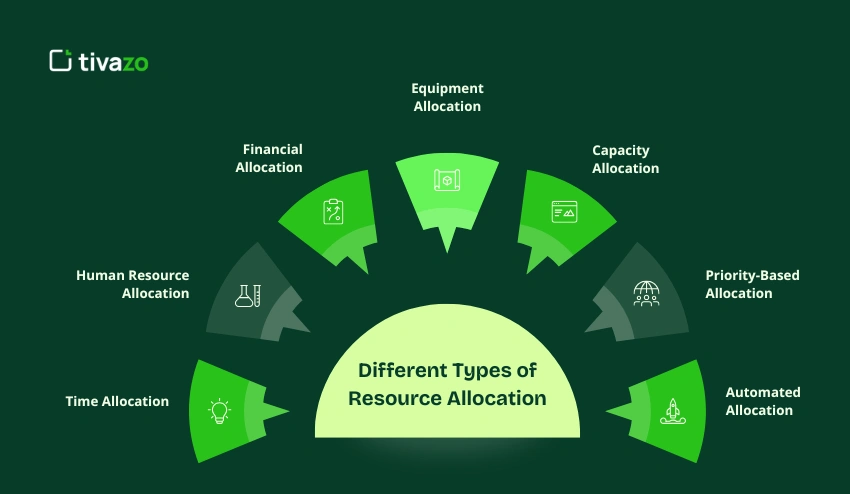Have you ever questioned yourself why certain projects go on as planned and others are always delayed, over budget, overruns, and overworked? This disparity is usually based on one thing, which is the allocation of resources. The manner in which you allocate resources, be it people, money, time, or equipment, can make or break a project.
Here in this guide, we are going to break down the different types of resource allocation and demonstrate to you how each of these forms is vital in project management, business strategy, and efficiency. Whether it is time allocation and workload balancing, the management of financial resources, or managing capacity, you will find out how organizations make sure the right resources are in place at the right time and the right place. We will also draw our attention to such modern practices as automated allocation and priority-based planning, and will also provide practical tips that most guides fail to consider.
Resource allocation is not only task assignment; it is the foundation of marketing resource management practices that propel productivity, minimize waste, and maximize value. Project management experts argue that proper allocation enables teams to set priorities on the activities of the teams that have limited resources, so that projects are completed on time and employees do not get burned out. No matter how you are dealing with human resource allocation, project scheduling, or how well you are determining how to optimize resources, it is important to know these types of resource allocation.
What is Resource Allocation?
Resource allocation refers to a strategic process of allocating the available resources to tasks, projects, or departments in order to realize goals efficiently in terms of people, time, money, equipment, and materials. In project management, it helps in ensuring that the correct resources are allocated to the correct activities at the correct time, eliminating bottlenecks, evenly allocating the workloads, and optimizing productivity.
Project management institute (PMI) indicates that effective allocation of resources extends beyond scheduling, but also allocation of limited resources according to the priorities of the business in order to bring the most value. It implies that organizations will always be in conflict of needs, foresee risks, and rearrange allocations when projects change.
In practice, resource allocation might look like:
- Assigning team members to specific tasks based on skills and availability.
- Planning time allocation to meet strict deadlines.
- Distributing budgets across multiple initiatives.
- Ensuring equipment or materials are available when needed.
Done well, resource allocation improves resource utilization, minimizes waste, and ensures smoother project execution. It is a cornerstone of resource management techniques, helping leaders adapt to changing priorities while keeping projects on track.
7 Different Types of Resource Allocation
All the project managers and business leaders must be aware of the different types of resource allocation so that their efficiency is fully realized and the wastage is minimized. With the correct allocation approach, be it time, budget, and skills, you could enhance resource usage and result in a higher outcome.
We will discuss the seven major types of resource allocation that organizations employ to allocate their resources in an effective manner.

1. Time Allocation
One of the most common types of resource allocation is time allocation, whereby tasks and times are allocated carefully on hours and time. This approach will make sure that projects run progressively without overwhelming members of the team. Time happens to be one of the most limited resources; thus, time allocation in the projects is effective and helps eliminate bottlenecks and enhance the project scheduling.
Managers in sectors such as IT or marketing usually utilize Gantt charts, timelines, as well as agile sprint planning in order to make proper allocation of time. This can be used to balance the workload and, at the same time, give the appropriate attention to every task. The costly delays, deadlines, and low productivity may be caused by the misallocation of time.
The actual use of time-based resource allocation is that it helps in aligning deadlines with the availability of resources. Managers can also be able to determine what is critical, use the Critical Path Method (CPM), and coordinate the flow of a project with proper planning of time. This strike is invaluable to the satisfaction of teams and clients.
2. Human Resource Allocation
Human resource allocation, as compared to the other types of resource allocation, is most likely to have an effect. It entails allocating team members to the projects according to their skills, experience, and availability. This practice will make sure that workers are not overworked or underworked and thus have better methods of managing their resources.
When properly planned, the human resource allocation strategy involves skill mapping, and the right amount of talent is put in the right position. If there is a need to assign percentages of time to various projects, they can be managed by managers to track availability. This avoids overloading of top performers and allow others to have a chance of being developed, hence resulting in resource optimization.
More so, job satisfaction and low turnover are encouraged through matching jobs with the strengths of the employees. Combining workload balancing and skill development options will not only make the project a better place to be but also enhance employee morale and retention in the long run.
3. Financial Allocation
Finance allocation can be defined as the allocation of budgets to tasks, departments, or projects. It is considered one of the most demanding types of resource allocation since financial resources are what make the difference between successful and failing projects. Projects could also fail to generate ROI because, without having financial resource planning, they could end up without funds halfway through.
Practically, organizations use funds depending on the strategic objectives, strategic goals, or returns. As an example, more urgent projects such as product launches or digital transformation projects usually get a greater portion of the budget. This approach to resource allocation is equal to the distribution of money where it has the most.
A good financial allocation plan also comprises contingency funds to take care of unexpected expenses. Businesses can optimize flows of financial resources by constantly measuring and distributing according to performance to be able to provide capital to drive growth.
4. Equipment Allocation
The process of deploying equipment or machinery, or technology to a task or project is referred to as equipment allocation. It is one of the most important types of resource allocation in the construction, manufacturing, and IT industries, as the unavailability of equipment can stall an entire process.
To illustrate, the placement of specialized machines in the appropriate production line will ensure a smooth-running line and avoid downtime. Using resource distribution systems, the companies are able to plan and monitor the usage of equipment in more than one project to prevent conflicts. This results in an increase in the rate of resource usage and an increase in the efficiency of the production cycles.
The equipment allocation is now less cumbersome with the use of technology, real-time tracking, IoT sensors, and digital asset management platforms. With the help of such tools, organizations can not only save time spent on idle time but also help to save on costs through avoiding the same purchases or needless rentals.
5. Capacity Allocation
Capacity allocation entails the examination of the amount of work that could be done by a team, system, or resource during a specific time. These types of resource allocation prove to be very handy in an organization that has various projects being handled at the same time. It allows leaders to avoid over-committing themselves and assists in making good capacity plans.
Historical data, forecasts, and workload trends are usually used by managers to make realistic expectations. They can match project requirements to team capabilities and therefore make sure that they are not overstretching their resources. This method also aids in the optimization of the resources, wherein no resources go to waste.
Capacity-based allocation enhances sustainability in the long term by balancing between short-term deliverables and long-term growth. It allows the company to be innovative and keep its resources malleable enough to address unforeseen issues.
6. Priority-Based Allocation
Priority-based allocation is done to make sure that the most urgent projects are initially allocated. Among all the forms of resource allocation, this one is the most strategic goal-oriented one since it is more concerned with business value maximization. Priority-based allocation aids in decision-making when there is a shortage of resources, and it is used to select those that are of greatest priority.
The technique is based on the prioritization of tasks or projects in terms of urgency, deadlines, or ROI. As an example, a project that is related to compliance or a client output can be assigned resources at the expense of internal projects. In this manner, resource management techniques directly contribute to the organizational strategy and undertakings for customers.
With priority-based resource allocation, organizations eliminate wastes, and unnecessary activities with low value do not consume scarce resources. It is an active methodology that enhances nimbleness and ensures that investments are geared towards long-term success.
7. Automated Allocation
The latest type of resource allocation is automated allocation, which involves the use of algorithms, AI, and software to allocate resources. Contrary to the manual allocation, automation takes into account a wide range of factors, such as skills, availability, and deadlines, to give optimal distribution.
Through the project management tools, companies are able to monitor the utilization, balance workloads, and project upcoming needs automatically. This not only enhances accuracy but also wastes less time for managers who would have taken long hours to schedule the project. Automated allocation also makes sure that the resources are always in tandem with the current business priorities.
With the increasingly complex businesses, automation will be a critical component of the resource allocation strategies. It reduces the chances of human error, enhances transparency, and enables leaders to respond swiftly to any sudden demand fluctuations.
Learning how to allocate these seven forms of resources will provide you with the knowledge to allocate resources more efficiently, minimize wastage, and become more productive. The trick is that you have to fit each type of allocation to the exact needs of your project, but you always need to track its optimization.
How these types map to common methods
Knowing the different types of resource allocation is not enough, but the second step is to observe how they relate to the popular project management techniques used. Allocating the different types of allocations to a technique assists teams in the execution of strategies in an efficient manner, enhancing the utilization of resources and also preventing bottlenecks. Various projects involve various strategies, and matching the types of allocation to effective methods is a sure way of achieving the best results.
As an example, time allocation is usually accompanied by the Critical Path Method (CPM), which determines the necessary tasks and steps to complete the deadlines. Likewise, resource leveling and resource smoothing methods are both closely associated with human resource allocation and capacity allocation, which helps eliminate over-commitment and distribute the workload across teams. The approaches also incorporate the concepts of project scheduling to make sure that the tasks are performed in the most effective sequence.
Other allocation types map naturally to modern tools and approaches:
- Financial allocation aligns with budgeting frameworks and cost management methods, ensuring resources are directed where they generate the most value.
- Priority-based allocation complements value-driven or portfolio management methods, which prioritize initiatives based on business impact.
- Automated allocation uses algorithms and AI integrated into project management software, creating optimized resource distribution with minimal manual intervention.
In knowing such mappings, organizations are able to exploit the kind of resource allocation tactics in a concerted effort to integrate the conventional styles, such as CPM, with the contemporary styles, such as AI-based automation. This is so that resources (human, financial, or physical) are never wasted on the project, aiming to maximize the output, reduction in wastage, and improve overall resource optimization.
Conclusion
To sum up, it is important to know the types of resource allocation, be it time allocation and human resource allocation, financial, equipment, capacity, priority-based, and automated allocation, in order to use the resource management techniques and better use of resources. Knowing the mapping of each type of allocation to the popular techniques such as project scheduling, capacity planning, and workload balancing, the organizations can optimally allocate the resources, decrease the bottlenecks, and match the efforts with the strategic priorities.
Application of these strategies not only maximizes resource optimisation, but also enables projects to be delivered in an efficient way, within time and budget, and eventually leads to improved business results. Are you willing to implement these allocation strategies in the following project?




